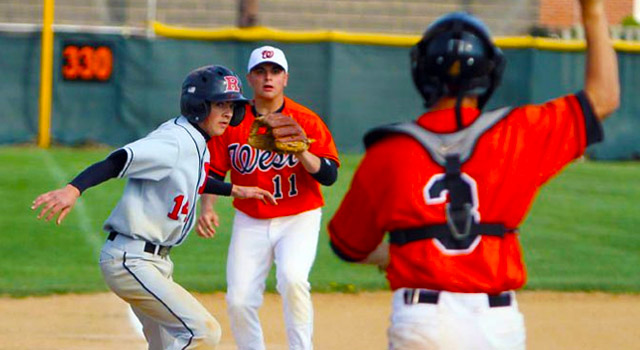Part 3 in a series discussing 1st and 3rd situations. Make sure to check out Part 1 and Part 2 as well.

First and third situations can present a good opportunity for the offensive team to score a much needed run. We’ve already looked at two different defensive plays in Part 1 and Part 2, so let’s jump right in to another defensive strategy: making a direct throw to third.
Offensive Strategy – Score a Run
When the offensive team calls a basic steal of second base, they are usually trying to accomplish one of two things. Either they are trying to stay out of the double play by getting the runner from first base to second base, or they are attempting to draw the catcher’s throw to second base in hopes of giving the runner on third a better chance at scoring. When the game is close, and the offensive team needs a run, you can bet they are going to try to score the runner on third by drawing the defense’s attention to the runner stealing second base.
Direct Throw to 3rd
As a coach, you’ll want to call this play when getting the lead runner out is a priority. Usually, the game is close, so the effect of that run scoring could have disastrous effects for your team. The runner on first does not matter, so if he wants to take second base, then we are going to let him have it so we can cut down the runner trying to score.
Catcher’s Responsibilities
The catcher has a simple task here. After he receives the pitch, he should pop up just like any other throw down to third base on a straight steal. He will be throwing directly to the third baseman who will be covering his base as the runner gets his secondary lead off of third.
There is no need for the catcher to fake a throw to second base. This is a quickness play, and we want the runner to be caught too far off the base. After the throw, the catcher should stay at home and be prepared in case the play turns into a rundown situation.
Third Baseman’s Responsibilities
The third baseman also has a simple goal here. He should being playing at a normal distance from 3rd base. After the pitch is delivered and he sees the catcher receive it, he should break for the bag and expect to receive the throw either on the run or as he arrives at the bag. His first priority is to tag the runner out as he slides back to the base. If the runner realizes he is dead in his tracks, chances are he will break for home or try to get caught in a rundown. If this happens, the third baseman needs get the ball out of his glove quickly and stay with the pace of the play. He may have to make a quick throw back to the catcher, or he may have to start the rundown. In either case, this lead runner is the focus of the play.
Middle Infielders’ Responsibilities
The shortstop should break for third base to back up for bad throws or get involved in a rundown if the situation calls for it.
The second baseman needs to break for second base as if he is covering for the throw from the catcher. He needs to make both runners and base coaches believe the throw is going to second base.
Pitcher and First Baseman’s Responsibility
After delivering the pitch, there is no need for the pitcher to become a spectator. He should make his way behind home plate to act as a backup for a bad throw or to help in a situation where a rundown may develop.
This goes for the first baseman as well. We do not care about the runner on first advancing to second, so there is no need to stay at first base. The first baseman should be behind home plate as a backup for bad throws and rundown situations.
Get the Lead Runner Out
Remember, this is just one play that can be implemented when trying to get the lead runner out. If we cannot get the runner out, we at least want to prevent him from scoring by keeping him at third. The ideal situation would have the play end with the runner on third called out and a runner now on second. By no means do we want the run to score and the runner on second to be safe. So, if we cannot get the lead runner out, we want to at least keep him on third.
Leave a Reply